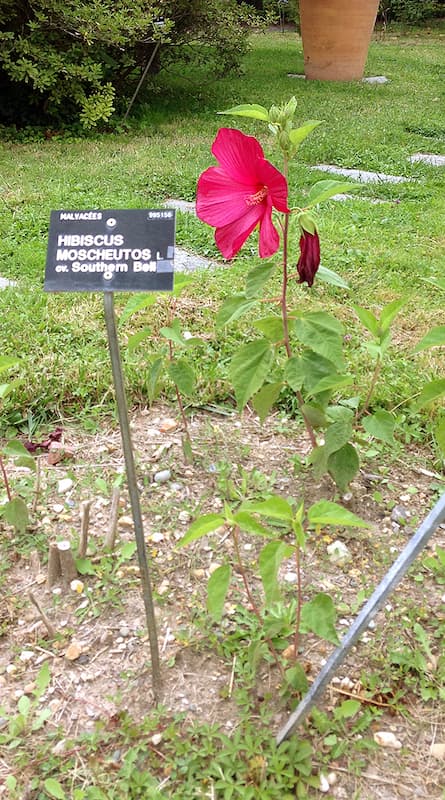Your cart is currently empty!
Swamp Rose Mallow, known as hibiscus moscheutos, has exotic, oversized flowers that are very striking. There are five overlapping petals, each with a reddish-purple to dark crimson base that forms a sharp contrast with the central eye of the flower. The bloom lasts only 1-2 days, but new flowers open every day over the long period from July to September. The large plants can produce up to 20 flowers per day at the height of their bloom. New growth, however, moves quite quickly once it begins. They are also known as hardy hibiscus and is tolerant of cold.
Can I Keep Swamp Rose Mallow in a Pot?
Maintaining and nurturing your swamp rose mellow in a pot is possible if you use an appropriate-sized container. Potted plants can generally be left outside unless the temperature drops below 20 degrees F (-5C) for extended periods. In the event of a cold snap, move the pot to a protected area until the weather warms up again.
Quick Growing Guide

Botanical Name: Hibiscus moscheutos
Also Called: Common rose mallow, swamp mallow, swamp hibiscus, dinner plate hibiscus
En français: Ketmie des marais
Sun / Shade:
Water: Keep wet or medium wet
Height:
Pollinators:
Care:

Pollinators
Bees are believed to be the primary pollinators of Swamp Rose Mallow, consuming vast quantities of its pollen. Butterflies visit the flowers purely for nectar; they have no interest in consuming pollen. Butterflies head for the nectaries, accessed through slits in their throats that may cause them to spread their own genes throughout nearby plants!
Bumblebees and other long-tongued bees help to cross-pollinate hibiscus moscheutos flowers. The Ruby-throated hummingbird is yet another nectar-seeking visitor of the rose-mallow flowers. The caterpillars of some butterflies and small insects feed on the nectar, the leaves, or the developing seeds. Similarly, the caterpillars of several moths also feed on swamp rose-mallow. The seeds of this plant are also a good source of food for birds in the fall and winter.
Caring for Swamp Rose Mallow
A native of wetlands and creek edges, rose mallow is found in the southeastern United States and Canada. The mallow plant grows best in full to partial sun in moist to continuously moist soils that contain loam, silt, or some sand with organic material. Plants with compact flowers can reach more than 12 inches across and come in a variety of colors.
You should water your rose mallow regularly, especially if they are growing in a container, especially in hotter weather. Due to its watering requirements, it is necessary to use well-draining soil and containers to prevent root rot. Your plant needs a good soak if its leaves are wilting. It is necessary to water your rose mallow plant early in the morning rather than late at night to prevent leaf fungus and other foliar diseases.
Water plants are especially important during the first growing season, but if they show signs of wilting, they should be watered immediately. During the growing season, feed rose mallow with a balanced, water-soluble fertilizer every six to eight weeks.
Is rose mallow edible?
Along with the flowers, swamp rose mallow leaf buds, and young leaves can also be eaten and are well edible. You can eat the leaf buds raw or cooked. Also, You can enhance the quality of your salads with the young leaves, which have a mild taste and a gelatinous consistency.
Growing Swamp Rose Mallow from seed
You can sow seeds your mallow seeds directly in your garden from spring to two months before they will grow in the weeks that lead up to the first killing frost. It is best to plant rose mallow in the early months of spring. Seeds should be started indoors eight to ten weeks before they are transplanted into the garden. Maintaining a temperature of 70°-75° F (low 20s degrees C) in the growing medium during the 15–30-day germination period is important. If these steps are followed through, you’ll be able to germinate rose mallow seeds successfully.
Growing mallow is easy, and you can start it from seed if you choose an area with moist, well-drained, organic soil and full sun. As a result, the latter encourages vigorous growth and reduces the need to stake. Ensure that seedlings are planted directly in the garden and maintain an evenly moist environment until they emerge.
Where to Plant Rose Mallow?
Knowing where plants may be found in nature is important to understanding where they should be planted. Hibiscus moscheutos enjoys moist, rainy environments like swamps, wetlands, creek edges and bogs in nature, but it also need a lot of sunshine to thrive. Plant swamp rose mallow along a stream or pond, or in a location of your garden that is naturally damp or can be maintained wet and moist, while still exposed to abundant sunlight.
Share with Family and Friends
Featured Authors
Visit a Botanical Garden For Unique Experiences.
Comments
Logging in to comment gives you more features, but it is not required.
Subscribe
0 Comments
Oldest












